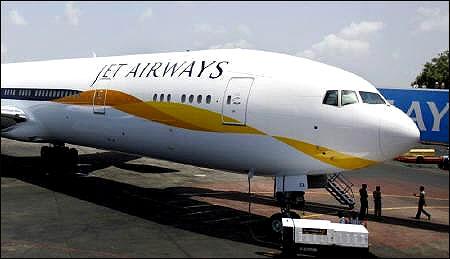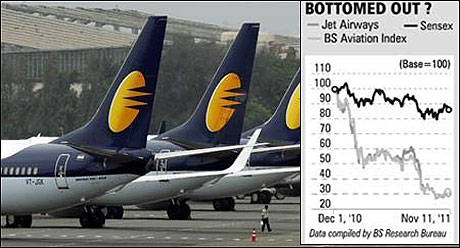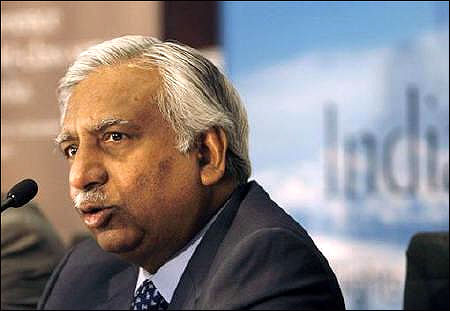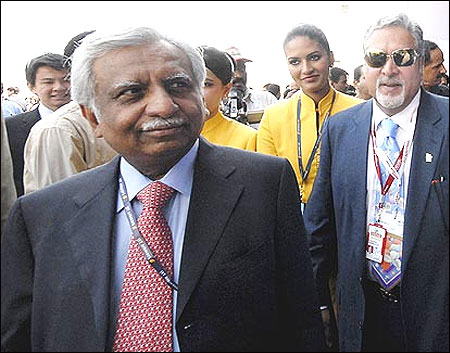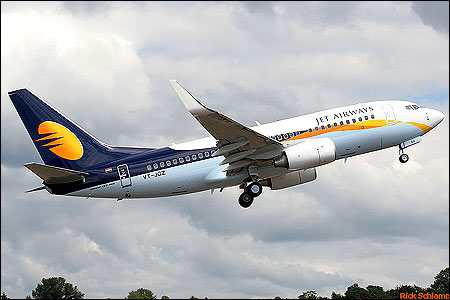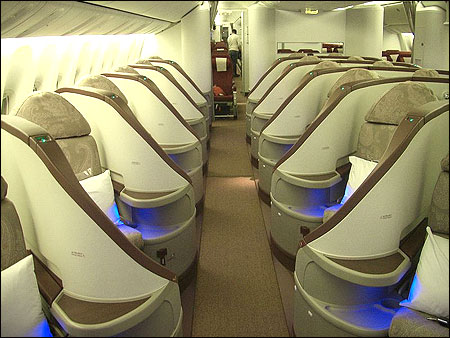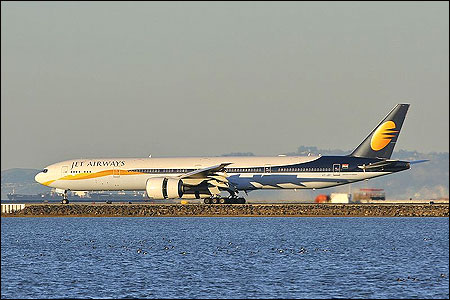 | « Back to article | Print this article |
Less turbulent skies ahead for Jet Airways
Jet Airways, the country's largest airline, has been a weak performer on the bourses for some time, losing nearly 70 per cent of its value in the past nine months.
A steep jump in costs and lack of pricing power has translated into increasing losses in the quarter ended September.
However, rising fares on higher demand, a drop in competitive intensity and a cost-cutting exercise are likely to help it improve its financials.
Click on NEXT for more...
Less turbulent skies ahead for Jet Airways
In a conference call after the company's results were announced, the management indicated onset of the peak season had led to price increases of 18-20 per cent across the board for the sector.
This, coupled with muted supply, should keep revenue robust for the current quarter as well as the second half of the financial year, which contributes about 55 per cent of its top line.
Click on NEXT for more...
Less turbulent skies ahead for Jet Airways
It has also planned to reduce its debt pile of Rs 14,000 crore (Rs 140 billion) from sale and lease-back of planes (Rs 750-1,500 crore (Rs 7.5-15 billion) and a deal with Godrej Property for the Bandra Kurla Complex in Mumbai (Rs 500 crore (Rs 5 billion) over the next few quarters.
However, despite these gains, the company is unlikely to make profits in the current financial year, say analysts.
The stock saw extreme volatility falling 11 per cent intra-day on Monday (Nov 14), but recovered to close at Rs 260, down two per cent over Friday's (Nov 11) close.
Click on NEXT for more...
Less turbulent skies ahead for Jet Airways
Though there are signs of improvement, given the poor September quarter results and the hardening of crude oil prices (amid recent rupee depreciation), analysts have revised their stock price targets downwards, which range at Rs 250-270 currently.
| FUEL BLOW | ||
| In Rs crore | Q2, FY12 | FY12E |
| Net sales | 3,187 | 15,661 |
| Y-o-Y chg (%) | 7.3 | 11.8 |
| Fuel costs | 1,491 | – |
| Y-o-Y chg (%) | 50.0 | – |
| Ebitda | -141 | 61 |
| Y-o-Y chg (%) | – | -94.3 |
| Loss | -710 | -829 |
| E: Estimate % change is y-o-y Source: Citi Investment Research | ||
Click on NEXT for more...
Less turbulent skies ahead for Jet Airways
Kingfisher effect
The sector saw a year-on-year demand growth of 20 per cent in the September quarter and the trend is likely to hold.
The management believes lower capacity additions, as compared to the past, should help sustain the demand and revenue outlook. In addition, the problems at rival Kingfisher Airlines (KFA) should also aid in improving demand.
Click on NEXT for more...
Less turbulent skies ahead for Jet Airways
The company has benefited from the issues facing KFA, with the management confirming an improvement in the corporate traffic as well as load factors to 75 per cent levels from 72 per cent in the recent past.
One area Jet has benefited from is the high-margin corporate travel market, where it is estimated to have a 50 per cent share.
When an airline (like KFA) decreases its routes, the traffic is distributed to other airlines and with Jet Airways commanding the largest market share, its stands to reap most of the gains, say analysts.
Click on NEXT for more...
Less turbulent skies ahead for Jet Airways
Cutting costs, debts
While the improving demand is good, there is little the company can do about fuel, 41 per cent of its cost basket.
Still, it has identified key areas to cut overall cost, such as improving the aircraft utilisation and increasing the ancillary revenues.
The company has set a cost reduction target of five to 10 per cent over the next year in cost per available seat-km.
This defines what it costs to carry a passenger or an empty seat per km.
Click on NEXT for more...
Less turbulent skies ahead for Jet Airways
Jet is also looking at bringing down debt by about Rs 1,500 crore (Rs 15 billion) over the next few quarters.
While a depreciating rupee is a cause for concern, given a majority of debt is dollar-denominated, the repayment should help the company pay down part of its high-cost debt.
This would help save on interest costs, expected at Rs 860 crore (Rs 8.6 billion) for 2011-12 as compared to Rs 1,086 crore (Rs 10.86 billion) in 2010-11.
Click on NEXT for more...
Less turbulent skies ahead for Jet Airways
Muted quarter
Despite an improvement in all operating parameters such as demand, load factors, revenue per passenger and lower costs, higher fuel bills and lower pricing meant the breakeven load factors went up from 77 per cent in the year-ago quarter to 95 per cent in the recent one.
While fuel costs went up by 50 per cent year-on-year, average ticket prices came down by four per cent, to Rs 4,330.
Click on NEXT for more...
Less turbulent skies ahead for Jet Airways
The international business, which accounts for 60 per cent of revenue, de-risks Jet's business as compared to other players and is in much better shape than the domestic business.
The company reached loads of nearly 81 per cent as compared to the breakeven load factor of 86 per cent for the quarter and made operating profit of Rs 284 crore (Rs 2.84 billion) as compared to a loss of Rs 111 crore (Rs 1.11 billion) for the domestic business.
With this trend likely to continue and domestic outlook improving, things may get better for Jet.
